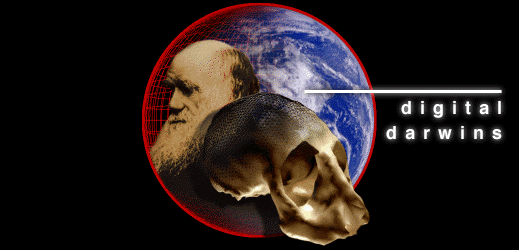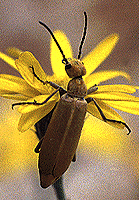Sites reviewed in this article:
Digital evolution is still busy trying to reach the point where technology becomes second nature, and organic life-forms are often used as models for the development of digital life. Various art and educational projects currently experiment with digital organisms and strive to simulate the evolution of digital life-forms (see IA Vol. 1 No. 1, "Missing Links of Digital Evolution" ). Coexisting with the projects dedicated to the evolution of the Web are those that use the Web to present information on the evolution of organic life-forms. Certain characteristics of the digital medium serve to illustrate the organic kind of evolution, which combines a linear and hierarchical development with a process of branching out and crossbreeding. The "network structure" of evolution can be illustrated nicely in media that allow navigational choices.
One of the projects dedicated to the evolution of organic life-forms is "The Tree of Life," a "phylogenetic navigator" designed to illustrate the diversity and unity of living organisms. The navigator translates the familiar structure of the family tree into the digital medium on a global scale: the Tree contains information about the phylogenetic relationships and characteristics of organisms, and features links to other biology sites. The project provides a guide to biological information that can be used by researchers, teachers, and students, and creates a forum for those who wish to share knowledge about the diversity of earth's organisms.
Visitors can browse the Tree by entering it at a chosen page, and wandering up and down the branches to other pages. They can climb up toward the tips of the Tree (or down towards the root) by clicking the names of organisms in the phylogeny or classification shown on a particular page. Each page presents information about a particular group of organisms. The beetle page, for example, shows pictures of beetles, introduces them, and provides a description of their key characteristics. Beginning from the root, one can follow ancestral lineages that either give rise to members of extinct families or lead to the ancestors of modern species; ancestors split into species that gave rise to suborders, which then further diversified... and so on. Part of what makes this tree climbing a fascinating experience is that the project combines the hierarchical and network elements of the evolutionary process.

The "Tree of Life" has been created by David Maddison (Department of Entomology) and Wayne Maddison (Department of Ecology and Evolutionary Biology) at the University of Arizona at Tucson; the root page of the entire Tree is housed on the home computer there. Appropriately enough, the project itself is distributed across numerous websites, and any one computer will house only a portion of the Tree's branches. The technological set-up of the Tree thus mimics the phylogenetic one: towards the tip of the tree, there could be hundreds of sites maintaining phylogenetic and other information on specific groups of organisms (as well as links to other resources on the Internet for a particular group).
Many contributors and specialists have helped to nurture the Tree and make it grow by working on the groups of organisms of their expertise. The project's organizers have developed tools to facilitate the building of Tree sites, so that specialists on a particular group can easily build a page and link it to the rest of the "Tree of Life."
As everything else on the Web, "The Tree of Life" is evolving. Currently it consists of more than 1150 pages--housed on 16 computers--and a few of them (e.g., the basal pages on beetles, jumping spiders, terrestrial vertebrates, amniotes, and sac fungi) are nearing completion. Other branches of the Tree are already very extensive, even though no single page within them is nearing completion. As the branches are growing, alternative phylogenetic hypotheses are discussed and further references are added. It will take time until all the Tree's branches will have started to grow, but, after all, the real Tree took over 3,000,000,000 years to evolve.

A different approach to visualizing evolution on the Web is taken by "Digital Darwins," an electronic museum and lab (housed at Mississippi State University) which allows visitors to examine three-dimensional digital specimens from the collections of the Smithsonian Institution and its partners. The objects were scanned at the Smithsonian Institution's Biovisualization Lab, and the site was developed by Charles Calvo, director of the digital research and imaging laboratory at Mississippi State's School of Architecture. The electronic museum doesn't provide information about Darwin but rather turns visitors into explorers in the tradition of Darwin, who collected and compared samples of nature during his five-year voyage around the globe (1831-1836) in a floating museum and lab called H.M.S. Beagle.
By comparing and zooming in on rotating VRML images, visitors to the lab can explore 15 specimens of anthropological importance ranging from skeletons (e.g. "Primates" or "Fossil Man") to stone tools and sculptures. The site offers low and high resolution versions of each of the objects as well as background information on them. The digital skulls may not be a replacement for the real thing but they offer access to specimens that would be out of reach for most people; and the great advantage of the digital models is that they can be analyzed without endangering the originals.
One can already imagine what these projects might look like in the next generation of Web evolution: the "Tree of Life" might be a VRML environment visitors can climb through, while the beetles and bugs morph through evolutionary stages right before their eyes; and "Digital Darwins" might allow visitors to zoom in on and slice the rotating skulls any way they want, revealing details they wouldn't be able to catch without digital enhancement.
|



